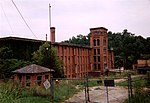Seneca Historic District (Seneca, South Carolina)
Buildings and structures in Oconee County, South CarolinaHistoric districts on the National Register of Historic Places in South CarolinaNRHP infobox with nocatNational Register of Historic Places in Oconee County, South CarolinaSeneca, South Carolina ... and 2 more
Upstate South Carolina Registered Historic Place stubsUse mdy dates from August 2023

Seneca Historic District is a historic district in Seneca, South Carolina, United States, that is listed on the National Register of Historic Places.
Excerpt from the Wikipedia article Seneca Historic District (Seneca, South Carolina) (License: CC BY-SA 3.0, Authors, Images).Seneca Historic District (Seneca, South Carolina)
West South 1st Street,
Geographical coordinates (GPS) Address Nearby Places Show on map
Geographical coordinates (GPS)
| Latitude | Longitude |
|---|---|
| N 34.683611111111 ° | E -82.956944444444 ° |
Address
West South 1st Street 240
29678
South Carolina, United States
Open on Google Maps





